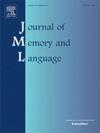A distributional model of concepts grounded in the spatial organization of objects
IF 3
1区 心理学
Q1 LINGUISTICS
引用次数: 0
Abstract
Data-driven models of concepts are gaining popularity in Psychology and Cognitive Science. Distributional semantic models represent word meanings as abstract word co-occurrence patterns, and excel at capturing human meaning intuitions about conceptual relationships; however, they lack the explicit links to the physical world that humans acquire through perception. Computer vision neural networks, on the other hand, can produce representations of visually-grounded concepts, but they do not support the extraction of information about the relationships between objects. To bridge the gap between distributional semantic models and computer vision networks, we introduce SemanticScape, a model of semantic concepts grounded in the visual relationships between objects in natural images. The model captures the latent statistics of the spatial organization of objects in the visual environment. Its implementation is based on the calculation of the summed Euclidean distances between all object pairs in visual scenes, which are then abstracted by means of dimensionality reduction. We validate our model against human explicit intuitions on semantic and visual similarity, relatedness, analogical reasoning, and several semantic and visual implicit processing measurements. Our results show that SemanticScape explains variance in human responses in the semantic tasks above and beyond what can be accounted for by standard distributional semantic models and convolutional neural networks; however, it is not predictive of human performance in implicit perceptual tasks. Our findings highlight that implicit information about the objects’ spatial distribution in the environment has a specific impact on semantic processing, demonstrating the importance of this often neglected experiential source.
一种基于物体空间组织的概念分布模型
数据驱动的概念模型在心理学和认知科学中越来越受欢迎。分布语义模型将词义表示为抽象的词共现模式,擅长捕捉人类关于概念关系的意义直觉;然而,它们缺乏人类通过感知获得的与物理世界的明确联系。另一方面,计算机视觉神经网络可以产生基于视觉的概念的表示,但它们不支持对象之间关系的信息提取。为了弥合分布式语义模型和计算机视觉网络之间的差距,我们引入了semantic scape,这是一个基于自然图像中对象之间视觉关系的语义概念模型。该模型捕获了视觉环境中物体空间组织的潜在统计信息。它的实现是基于计算视觉场景中所有物体对之间的欧氏距离的总和,然后通过降维的方法对其进行抽象。我们在语义和视觉相似性、相关性、类比推理以及一些语义和视觉内隐处理测量上验证了我们的模型。我们的研究结果表明,SemanticScape解释了人类在语义任务中的反应差异,超出了标准分布语义模型和卷积神经网络所能解释的范围;然而,它并不能预测人类在内隐感知任务中的表现。我们的研究结果强调,关于物体在环境中的空间分布的隐式信息对语义处理有特定的影响,证明了这一经常被忽视的经验来源的重要性。
本文章由计算机程序翻译,如有差异,请以英文原文为准。
求助全文
约1分钟内获得全文
求助全文
来源期刊
CiteScore
8.70
自引率
14.00%
发文量
49
审稿时长
12.7 weeks
期刊介绍:
Articles in the Journal of Memory and Language contribute to the formulation of scientific issues and theories in the areas of memory, language comprehension and production, and cognitive processes. Special emphasis is given to research articles that provide new theoretical insights based on a carefully laid empirical foundation. The journal generally favors articles that provide multiple experiments. In addition, significant theoretical papers without new experimental findings may be published.
The Journal of Memory and Language is a valuable tool for cognitive scientists, including psychologists, linguists, and others interested in memory and learning, language, reading, and speech.
Research Areas include:
• Topics that illuminate aspects of memory or language processing
• Linguistics
• Neuropsychology.

 求助内容:
求助内容: 应助结果提醒方式:
应助结果提醒方式:


